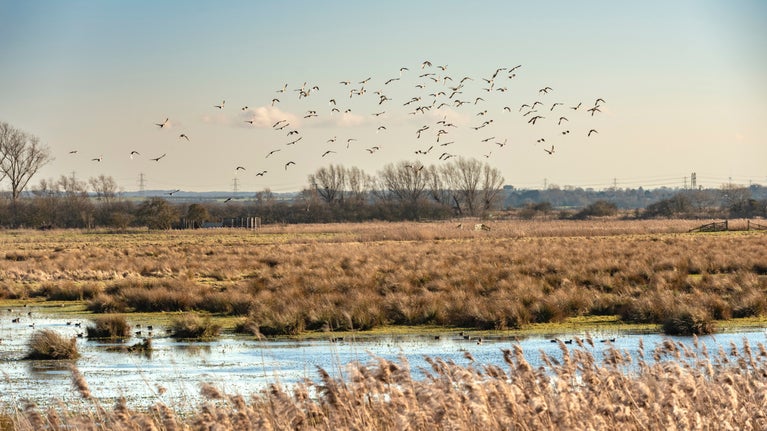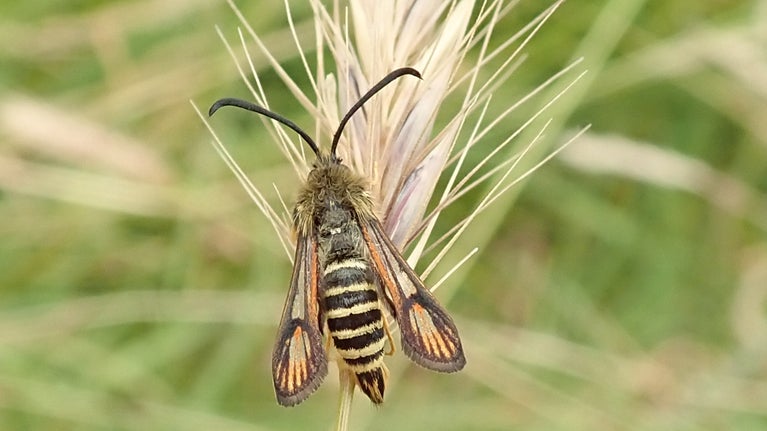Nature reserve becomes first in UK to record 10,000 species – with discovery of moth that imitates a wasp
- Published:
- 08 October 2025

A fenland nature reserve in Cambridgeshire has recorded its 10,000th species of wildlife – becoming, experts believe, the first known UK site of its kind to do so.
The National Trust’s Wicken Fen hit the total earlier this year when a rare species of moth was recorded on the reserve for the first time. The six-belted clearwing has a striped, yellow abdomen to mimic the appearance of a wasp, which helps it avoid predators.
The clearwing becomes the latest in an extensive line of species recorded on the site, which has long attracted natural history enthusiasts. Wildlife records date back 200 years, and during the 20th century, 13 species that are new to science were discovered on the reserve.
But it is during the last 25 years that records have really surged in number. Experts at the Trust say the boom in wildlife has been the result of a major expansion of the nature reserve that started in 1999, combined with warmer temperatures, which have caused many insects to move further north, and more sophisticated monitoring methods.
Alan Kell, Countryside Manager at the National Trust said: “Reaching 10,000 recorded species is a proud achievement for everyone who has ever taken an interest in this special corner of the country.
“When the National Trust bought Wicken for £10 back in 1899, it was only two acres in size. A concerted effort over time to expand, restore and care for it has created this haven for wildlife that is a thousand times the size it was, and we believe, the most biodiverse recorded reserve in the UK.
“I never fail to be surprised by what we find here, and it is absolutely a case in point that if you give nature the opportunity and the space, it will do remarkable things.”
The charity hopes species records will continue to climb as it today announces a major partnership with The Nature Recovery Project to help restore vast tracts of lowland peat, both at Wicken Fen and elsewhere in the country.
At Wicken, funding will create new areas of wetland habitat and preserve more lowland peat, as well as support innovative wetland farming techniques called paludiculture. The addition of nature-rich reservoirs will help manage water levels and support wildlife. It’ll form part of a wider push to turn the UK’s degrading lowland peat soils into thriving ecosystems.
James Berry, Head of Strategy at The Nature Recovery Project, said: “The Nature Recovery Project is excited about the opportunity to unite the critical environmental benefits of lowland peatland restoration with a sustainable commercial purpose. If the project can demonstrate that healthy, thriving peatlands can successfully coexist with profitable food production and nature, we anticipate that this approach could be adopted widely across both existing and historically degraded peatlands. This would unlock a powerful pathway for stopping emissions from the nation’s largest natural emitter.”
In 1999, the National Trust decided to compile a central checklist of biodiversity as part of its Wicken Fen Vision – a century-long plan to vastly increase the size of the reserve. With the help of professional and amateur naturalists, the Trust recorded a total of 7,421 species.
Since then, the site has more than tripled in size, from 225 hectares to 820 hectares, an expansion which is credited with boosting the area’s abundance and diversity of wildlife.
Recent finds include the formidable ant beetle, a scarce plant in the pea family called grass vetchling, and the evocatively-titled chamomile shark – a type of moth. New bird records include a white-tailed eagle that roosted for one night in 2022 and a white stork that was seen several times in summer 2023.
While over 10,000 different species have been recorded on the fen, some of them are now extinct at Wicken, namely the swallowtail butterfly, whose extinction due to habitat loss provided the inspiration for the Wicken Fen Vision.
Technology increasingly plays an important role in the recording of species. For the last two years, the nature reserve has taken part in The Bioscan Project led by The Wellcome Sanger Institute. DNA samples of insects found on the reserve, as well as other National Trust sites, are analysed and added to a central database to improve understanding of UK insect diversity and population trends.
Lyndall Pereira da Conceicoa, Bioscan Science Lead at The Wellcome Sanger Institute, said: “The Bioscan Project aims to revolutionise our understanding of insect diversity in the UK by using DNA barcoding to identify both known species and species that would otherwise remain unknown to science. Our ambition is to use this approach to track how diversity changes through space and time across the country. Sites like Wicken Fen, with their rich biodiversity and long-term monitoring, are invaluable partners in creating comprehensive baselines of UK insect species that will inform conservation efforts for years to come.”
Alan Kell continued: “It is vital that we continue to restore as much fenland habitat as possible. To do so we’ll need to work in partnership, including with funders like The Nature Recovery Project, and increasingly beyond the physical boundaries of the reserve with fellow landowners. The more space we can provide and the more wildlife ‘corridors’ we can create, the greater chance we have of being able to support even more species – especially in this changing climate.”

Wicken Fen’s Top 10 “Weird and Wonderful” species
As chosen by Wicken Fen’s Ajay Tegala
- Glow-worm - Weird Fact: Larvae sometimes ride on snails' backs and deliver a toxic bite to paralyze their prey.
- Common lizard - Weird Fact: If threatened by a predator, the common lizard will shed its still-moving tail in order to distract its attacker and make a quick getaway. It can regrow its tail, although it is usually shorter than the original.
- Fen nettle - Wonderful Fact: Although it looks like a common nettle, it lacks the typical stinging hairs of other nettles, instead having fine, dense, non-stinging hairs.
- Norfolk hawker - Wonderful Fact: Until relatively recently, this dragonfly was only found near the Norfolk Broads, but it has been spreading and now breeds on the Fen. Failed attempts were once made to introduce it at Wicken, a few years later it arrived naturally.
- Water vole - Wonderful Fact: Britain’s largest voles, they create complex burrows with underwater entrances and have unique behaviours such as kicking mud at predators.
- Cuckoo - Weird Fact: Cuckoos are famous for brood parasitism: laying their eggs in the nests of other birds, leaving the host parents to incubate their eggs and raise their young.
- Silver barred moth - Wonderful Fact: This very rare moth is only found at three other places in the UK, the larvae feed on just two specific species of grass.
- Water scorpion - Weird Fact: Not a true scorpion, although it looks like one. This underwater predator uses its front pincer-like legs to catch its prey (tadpoles and small fish). Its tail is a kind of snorkel, rather than a sting, which it uses to breathe underwater.
- Greater bladderwort - Weird Fact: A carnivorous aquatic plant, its underwater leaves have tiny bladders that create a vacuum to suck in prey, which it then digests. The plant is free-floating, without any roots.
- Clearwing moths - Weird and Wonderful Facts: Clearwing moths have the remarkable ability to mimic wasps and hornets, which helps them avoid predators by appearing to be stinging insects, some even imitate flight patterns and buzzing sounds, but they do not sting. The 10,000th species to be recorded on Wicken Fen was the Six-belted Clearwing, a nationally scarce species.